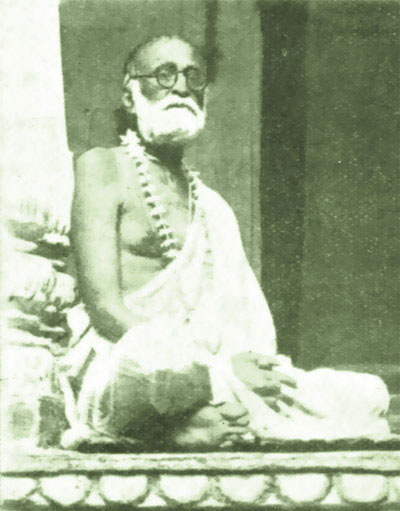śrī śrī guru gaurāṅga jayataḥ!
Year 9, Issue 1 Dedicated to Śrī Śrīmad Bhakti Prajñāna Keśava Gosvāmī Mahārāja Śrī Śrīmad Bhaktivedānta Nārāyaṇa Gosvāmī Mahārāja
Posted: 27 February 2016
nitya-līlā praviṣṭa oṁ viṣṇupāda
Inspired by and under the guidance of
nitya-līlā praviṣṭa oṁ viṣṇupāda
Uniformity - Part Two
by Śrīla Bhaktisiddhānta Sarasvatī Ṭhākura Prabhupāda

Click here to read Uniformity - Part One
Uniformity in the practices of neophytes is produced by subservience to the spiritual preceptor. He directs their activities by a kind of quasi-spiritual compulsion. The novice submits to be so coerced through his enlightened conviction of the spiritual mercy and the freedom-giving quality of such guidance. It is very different from any form of mechanical subservience to non-spiritual authority.
Those who might have had the opportunity to closely follow the daily life of the residents of the Gauḍīya Maṭha should have been struck by the genuine and perfect elasticity and freedom from mechanical conduct, even of those who perform what appear to be a stereotyped course of ritualistic activities. The person who, day after day, makes offerings to the emblematic holy form of the Divinity in the temple by the recital of identical mantras , is as much a strenuous and humble seeker of the Living Truth by the full exercise of his individual judgement as the person who expounds the abstruse philosophy of Śrīmad-Bhāgavatam in the temple’s kīrtana hall, which is seen as the most important part of daily worship. There is the closest , realized connection between the exposition in the kīrtana hall and the ceremony of “waving the light” that is performed with the recital of mantra before the figure of the deity.
The only point the Śrīmad-Bhāgavatam is never tired of insisting upon is this: if any activity ceases to possess spiritual vitality – or in other words if it degenerates into an affair of this mundane world – it is never accepted by Divinity. All acts of worship have to be performed on the plane of transcendence by the resources afforded to us through our practice of spiritual life. Every resident of the Gauḍīya Maṭha presents conduct embodying the teachings of Śrīmad-Bhāgavatam for the reverential inspection of all who behold their activities. And yet no two residents of the maṭha do the exact same work.
The maṭha is the spiritual house of God. The residents of the maṭha are spiritual survivors in the household of Kṛṣṇa. Daily life in the maṭha is dedicated to spiritual service to Kṛṣṇa. Kṛṣṇa is the proprietor of the household, and He is the only proprietor. All else is His property. The souls of all entities are His property. The physical body and the material mind behind an activity have no access to the plane of service to Kṛṣṇa. But the physical body and the material mind are made eligible to serve Kṛṣṇa by the process of dīkṣā (initiation into transcendental knowledge, or Veda).
As soon as the body and mind are voluntarily surrendered to Kṛṣṇa at the time of being initiated by the spiritual preceptor, they are lifted to the level of the soul by the mercy of Kṛṣṇa. Such a body and mind are fit to be employed in transcendental service to Kṛṣṇa. The residents of the maṭha , therefore, do not serve Kṛṣṇa by the physical body and material mind. For this reason they are relieved from the necessity of lifeless uniformity of conduct that would otherwise be imposed on them, to ensure the orderliness of corporate activities.
The waving of the light before the emblematic figure of the Divinity is as much an activity of the soul as the exposition of the Bhāgavatam when each is performed by the pure devotee of Kṛṣṇa. But the performance of apparently identical versions of these activities by conditioned souls possesses no spiritual value whatsoever. The living reality of this distinction between the two is made clear to all open minded people who are willing to witness with faith the performances of the residents of the maṭha .
No one whose spiritual nature has been restored to a state of unfettered transcendental activity by the mercy of the spiritual preceptor can do anything that is amiss. This establishes the automatic and perfect uniformity of all living worship. But it is not open to the view of the mundane spectator.
The uniformity that is sought to be established on the physical and mental planes in regard to so-called worship has been the cause of direct or indirect religious persecution in the religious history of the world. The attempt to realize a universal uniformity of doctrine and practice is the result of a profound urge of the human nature and cannot be neglected except through utter despair. But the longing for realization of it is nevertheless wholly legitimate and capable of fulfilment on the plane of unalloyed spiritual activity, in the shape of the perfectly free activities of the spiritualized body and mind.
Adapted from The Gaudiya, Volume 45, Number 6
by the Rays of The Harmonist team